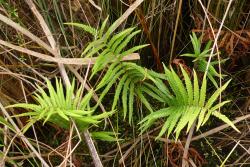Terrestrial ferns. Rhizomes long-creeping, scaly. Rhizome scales narrowly to broadly ovate, setiferous (not NZ) or entire (NZ). Fronds monomorphic. Stipes scaly, minutely hairy or glabrous. Laminae 1-pinnate to 1-pinnate-pinnatifid, coriaceous, proximal pinnae not reduced in size; basal pinnae not conspicuously auricled; aerophores absent; abaxial surface of laminae bearing scales on costae, bearing acicular hairs but lacking capitate hairs on the lamina surfaces, or glabrous, and often bearing spherical red or orange glands on the costae. One or more basal veins from adjacent pinna lobes always uniting below the sinus. Sori round, indusiate; paraphyses absent. Indusia reniform, bearing acicular hairs. Sporangia lacking glands or hairs near the annulus, but bearing a multicellular hair with a terminal spherical red or orange gland on the stalk. Spores monolete, finely and irregularly spinulose.
Allan (1961) included all indigenous New Zealand species of Thelypteridaceae within a broadly construed Thelypteris. Holttum (1971) distinguished Cyclosorus as a genus with long-creeping rhizomes, the basal pinnae not reduced, thin flat scales present on the lower surface of the costae, and spherical glands present on the lower surface of the veins and at the ends of multicellular hairs on the stalks of the sporangia. Holttum’s concept remained unchanged following the classification of Fawcett & Smith (2021).
A pantropical genus of 2–3 species (Fawcett & Smith 2021). One species in Australia (Bostock 1998) and the Pacific (Holttum 1977). One species in New Zealand; none endemic.
| Category | Number |
|---|---|
| Indigenous (Non-endemic) | 1 |
| Total | 1 |
The base chromosome number in Cyclosorus is x = 36 (Holttum 1971; Smith 1990; Fawcett & Smith 2021).




